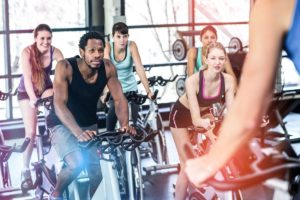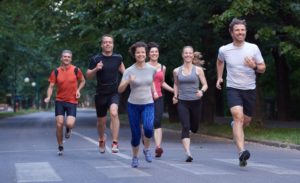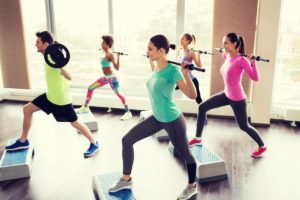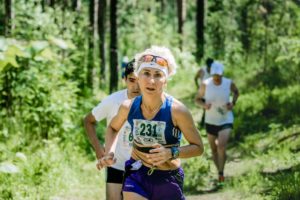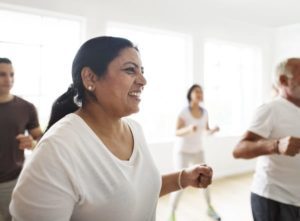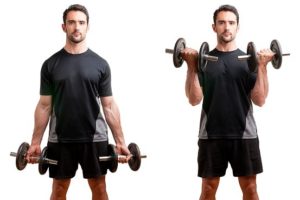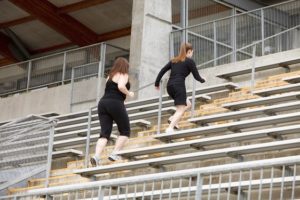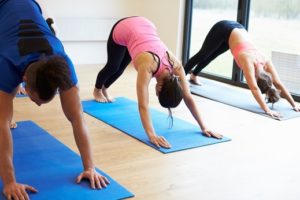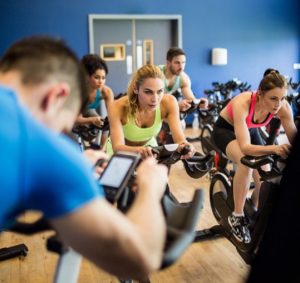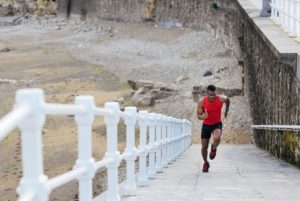Cardio/Aerobic Training
Turn Negatives Into Positives
I was a new group fitness instructor taking someone else’s muscle-toning class. “You’re not going low enough,” the instructor yelled at me from across the crowded room. As flames of embarrassment burned my cheeks, I dropped lower into the Romanian dead lift even though I had just come from teaching my seventh cycling class of the week and my body was spent. But this was what the class required, I rationalized, and I was fit—I should be able to keep up.
Unfortunately, I couldn’t keep up, and as a result, I gave myself a nagging lower-back injury.
Creative Ideas That Inspire
Cardio Sweat Party, at Power Studios in New York City, was designed by Michele Gordon. It combines kickboxing with dance, athletic drills and upbeat music for a 55-minute, high-energy experience. Classes are open to all fitness levels, and each class begins with a dynamic, kickboxing- based warmup before moving into three to four segments of choreography. In between the choreographed moves, rounds of squats, lunges, jacks, burpees, mountain climbers and other athletic drills round out the experience.
Sample Class: Rock and Ride!
Many indoor cycling instructors are not sure of the best way to combine strength and cycling without compromising either component. Rock and Ride provides the perfect mix of both while infusing a little fun with rock ’n’ roll music. This class is an ideal introduction for new riders because, instead of having to “suffer” through 60 minutes on an uncomfortable saddle, they get to hop off at the midpoint for strength work.
CrossFit® Benefits People With Type 2 Diabetes
A common characteristic among people with type 2 diabetes is dysfunction of beta cells, which are responsible for storing and releasing insulin. New research suggests that high-intensity training workouts may help to restore beta-cell function.
Running Marathons Isn’t Bad for the Heart
Several past research studies have warned that high levels of endurance exercise—like running multiple marathons—could be a risk factor for future heart problems. According to a study from the Technical University of Munich in Germany, there’s no need to give up those marathons just yet.
Activity Helps Heart Attack Sufferers Survive
No one plans to have a heart attack; however, should one occur, a new study has determined that an active lifestyle ups the likelihood of survival.
Can You Catch the Running Bug?
What do the common cold, the flu and running have in common? All three are contagious, according to a new study.
Fitness and Flexible Blood Vessels
Clients often focus on the many aesthetic benefits of exercise, including weight loss and improved skin tone (Jaret 2011). Remind your hard-working clients of the numerous other benefits they’re reaping when they’re repping—the good stuff that happens behind the scenes, or rather, beneath the skin.
Creative ideas that Inspire
Rumble at Rebel in London is a high-energy HIIT format in a fully immersive environment. With low, creative lighting and a specially curated soundtrack, participants build strength with explosive speed as they punch, jab and perfect their boxing footwork in “a cardio boxing battle that’s no holds barred.” The gym, which has two locations, also features an adjacent hair salon where participants can go after their class for a blow dry, cut, beard trim or other beauty service.
A 55-Minute Lower-Body Workout With Strength and Cardio Intervals
Help your students improve lower-body strength by taking them through unique variations of the lunge, squat and dead lift.
Yoga and Prehypertension
Adding to the growing evidence of yoga’s health benefits, preliminary findings from a recent study show that consistent yoga practice may help to reduce blood pressure among people with prehypertension.
Women Who Run Marathons Have Lower Coronary Plaque Buildup
Ladies: Lace up those tennies. According to new research, women who regularly complete marathons have less coronary-plaque buildup—and therefore a lower risk of stroke or heart attack—than sedentary women.
Is There a Best Place to Wear a Heart Rate Monitor?
With heart rate monitors, where you place them may determine how accurate they are, according to data published in the Journal of the College of Cardiology (2017; 69 [11], 336).
Reducing CVD Risk in Older Adults Who Are Obese
Exercise may protect against cardiovascular disease regardless of body mass index, according to researchers from Erasmus University Medical Centre in Rotterdam, the Netherlands.
They examined the health records and activity levels of 5,344 adults aged 55—97. Participants were categorized as normal weight, overweight or obese and were also classified by activity level. The study's purpose was to understand associations among weight, physical activity levels and CVD risk.
Movement Helps Kids’ Arteries
It's been documented that active kids tend to perform better in school, are less likely to gain excess weight, develop stronger muscles and bones, and much more. A new report published in Pediatric Exercise Science (2017. doi: http://dx.doi.org/10.1123/pes.2016–0168) adds improved arterial health to the list of benefits.
Resistance Training and the Cardiorespiratory Response
We know that resistance training improves strength, but can it also challenge the cardiorespiratory system? In a study published in The Journal of Strength & Conditioning Research (2017; 31[3], 644—52), researchers analyzed the effects of three exercises performed three different ways, to determine the cardiorespiratory response to each.
Brief Bouts of Stair Climbing Boost Fitness Levels
Lack of time and no access to fitness equipment are two of the most common responses given by people who do not exercise. Researchers at McMaster University and Queens University, in Ontario, have released a report suggesting a workaround to those responses. The scientists have found that very short bouts of stair climbing can help people get in better shape.
Creative Ideas That Inspire
H.I.I.P. Hype (High-Intensity Interval Painting) in New York challenges body, mind and creativity. Ninety–minute sessions begin with a warm-up followed by short intervals of high-intensity body-weight exercises interspersed with periods of painting. The energy participants generate while exercising helps them express themselves more freely when they paint, according to organizers. The last 15 minutes of class are reserved for a cool-down, as well as painting presentations. Mats and art materials are provided.
Fewer Repetitions Means Better Results?
Short-duration workouts have become popular over the past several years as the time-crunched seek out effective ways to exercise. Recent research adds more support for the benefits of fast workouts and indicates that less may even be more, provided you have appropriate equipment.
The Physiology of Sprint Interval Training
If your clients haven't already asked you about it, they will. High-intensity interval training is a mainstay in personal training programs and group fitness classes. There are several reasons why HIIT is a good workout, one of them being its brevity. Research indicates that the four most common barriers to exercise are not having time, feeling too tired, getting enough exercise at one's job, and having no motivation to exercise (Brownson et al. 2001).


